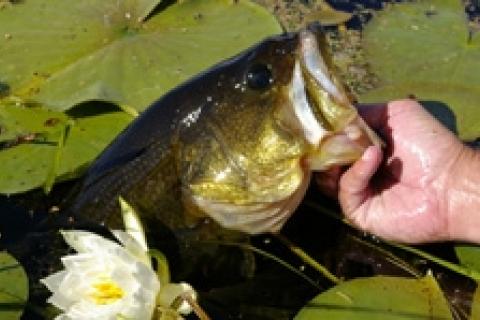
For those in search of exhilarating fishing excitement, airborne acrobatics, and a strong pull on the line, look no further than Micropterus Salmoides — or the largemouth bass to those that ducked out of Latin class.
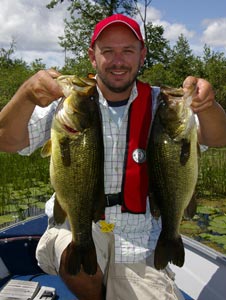 The largemouth bass is North America's most popular game fish, with a habitat range that runs from Canada in the north to the southern states down below — including the temperate region of Mexico. With its accessible nature and ability to strike a wide-variety of lures, it's no wonder that Mr. Bucketmouth holds a treasured place in anglers hearts and minds everywhere. Come and discover the joy that is bass fishing — and welcome to the club that will bring smiles and joy season after glorious season.
The largemouth bass is North America's most popular game fish, with a habitat range that runs from Canada in the north to the southern states down below — including the temperate region of Mexico. With its accessible nature and ability to strike a wide-variety of lures, it's no wonder that Mr. Bucketmouth holds a treasured place in anglers hearts and minds everywhere. Come and discover the joy that is bass fishing — and welcome to the club that will bring smiles and joy season after glorious season.
Bass Fishing is a Sport for Everyone
One of the greatest aspects of bass fishing is that anyone can do it. A simple statement, but one that holds true regardless of your experience level, financial position, or background. Although a high-priced bass boat and top-of-the-line equipment would certainly bring added enjoyment, the same can be said for sitting on the shore, with only a handful of lures and an inexpensive rod to keep you company.
From young to old alike, a jostling bass at the end of the line will always get the heart rate up a notch or two.
Another positive about largemouth bass is that they can be found in most lakes, rivers, streams and ponds across this great continent of ours. Contacting the local Natural Resources office can head you in the right direction in terms of narrowing down what body of water the fish reside in, and also stocking and population records. (This can be extremely useful; as it will tell you what lakes you have an improved chance of catching fish out of.)
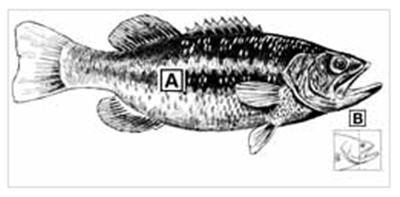
Largemouth Bass Identification
A: Definite lateral stripe
B: Jaw extends well behind the back margin of the eye when mouth is closed
Largemouth Bass Species Details
Besides the obvious traits, largemouth bass will fight hard, are extremely palatable for the dinner table, and are cunning enough to provide excitement and intrigue, while matching wits each time you head to the lake. They are also the number one game fish when it comes to tournaments, which can be another interesting and fulfilling endeavor for those looking to hone their bassin' skills. And to top it all off, they are a great fish for the entire family to target. From young to old alike, a jostling bass at the end of the line will always get the heart rate up a notch or two.
And in case you thought otherwise, I bet you there's a lake or pond within driving distance of your house, just teeming with hungry largemouth waiting to be caught. You won't know unless you give it a try, and I can guarantee that you'll become hooked!
What do Bass Like to Eat?
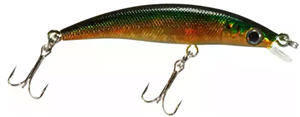
When it comes to food, largemouth bass are called "bucketmouths" for good reason. They will eat a wide variety of prey, but the top three choices would have to be baitfish (perch, bluegills, minnows), crawfish and frogs. Due to the size of their cavernous mouths, bass can eat prey up to half the size of their body length in some cases. (It's not uncommon to find 10-inch perch or jumbo bullfrogs inside the stomach cavities of this freshwater adversary!) The neat thing about the largemouth bass is that you can catch them on a wide variety of lures, from topwater hardbaits to plastic softbaits,and minnow baits like the Bass Pro Shops XTS Lures Minnow to actual live bait.
Where Can I Find Bass?
For those new to the sport of bass fishing, the one question that may be on your mind is "where do I find them?" Although there are numerous places in a body of water that Mr. Bucketmouth can be found, the most important ingredient for finding success is vegetation (Or weeds to most of us.) Largemouth bass and weeds go hand-in-hand, and very rarely will you find one without the other. The vegetation that you will be searching for can be varied, although a few top choices are lily pads, hydrilla, bulrushes, grasses, and coontail. Bass use this vegetation for a number of different reasons, namely shelter, protection and as an ambush point for capturing prey. (Weeds also attract many types of baitfish and other food sources, hence the presence of the marauding bass.)
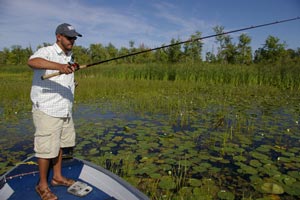
Light penetration is also another valid ingredient. As the sun reaches higher in the sky, largemouth will retreat from the open areas in order to bury in the weeds, searching out the cooler water that this shade provides.The warmer and sunnier the day is, the tighter in to cover the bass will be found.(A good point to keep tucked under your hat.)It also goes without saying that cloud cover, rain, dusk or dawn pull the bass farther out from the weeds as they more actively roam in search of food during these low-light periods.During conditions like these, the largemouth bass will become more aggressive and generally easier to catch.If you can get yourself out of bed before dawn or stick around until the sun goes down, you may just experience some fast-paced action that is sure to get your adrenaline going.
If you haven't guessed by now, vegetation provides a structure point for bass to key in on. Other excellent sources of structure that bass will relate to are boat docks (they love to hide underneath in the dark recesses), stumps, logs and fallen trees (underneath and alongside the wood), undercut banks (underneath) and bridge pilings (adjacent to the structure itself.) Finding these types of cover will help you in locating the bass that call these places home.
A great way to put a bend in your rod is to always think of bass fishing as a game of hide-and-go-seek. Try to uncover the hidden fish and eventually you will find them.
Largemouth Thrive in Shallow Water
Another important aspect to consider when searching for largemouth bass is their affinity for shallow water. Unlike their cousin the smallmouth bass, largemouth thrive in skinny water, meaning that 75 percent of my fishing is done in depths of 10 feet or less. Sure, bass can be found in deeper water under certain conditions, but for my money, I'd have to bet on shallow water for coughing up the most fish on a consistent basis. Shore anglers can certainly excel by grasping this information, as moving up and down a shoreline on foot can be the best way to thoroughly cover this prime bass habitat.
The most important piece of advice I can give to those interested in bass fishing is to stay focused and to have fun. Whether you catch one fish or twenty, practicing and mastering new techniques and tactics are two sure-fire ways to bring down the learning curve. Bass fishing is a wonderful sport that is fun for the entire family — take it from me, it will become very, very addictive in no time flat. Have a great season and go catch a bunch!
- 28632 views

